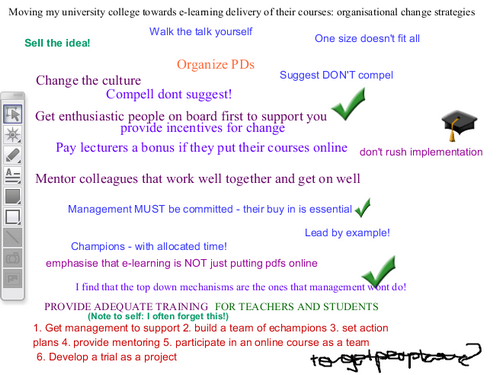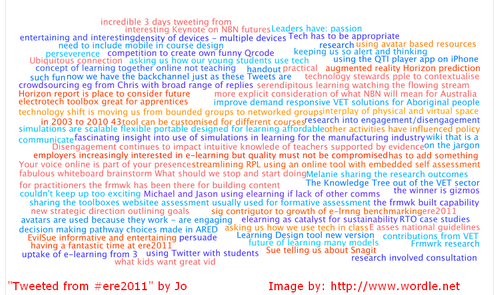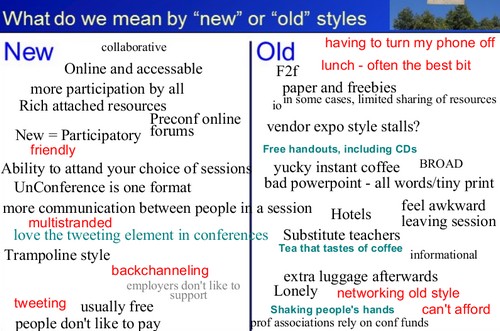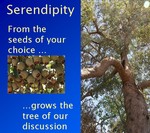Introduction
I was thinking yesterday about a recent event where I found myself standing up for 25 minutes in front of a potentially negative audience of colleagues. My brief was to give them a look at what is “out there” in terms of future online/e-learning possibilties that might be significant for them.
The contemplation was triggered in part by elements of a long conversation between myself @mgraffin and @philhart when we met for lunch in Perth yesterday. As seems inevitable when “e” minded educators meet we touched upon the issue of encouraging our emphatically non “e”, non tech colleagues to at least explore the possiblities and dip a toe in the water.
Consequences of Shyness
Later on when Phil and myself were cooking dinner we returned to the theme and diversified into some of the underlying personality traits, ideas and strategies that inform how we interact with students and colleagues. As a child and teenager I was paralysingly shy, would rarely speak in any group situation, and always hid at the back. However I also took part regularly in school drama productions! I found I could do this by adopting a different persona, in a way I was standing outside myself and becoming consciously an entertainer. The shyness is still there especially when I meet face-to-face with new people although I can now mask it fairly well. It fascinates me that I am far less shy in my online persona particularly on Twitter and in Elluminate. There are many possible reasons for this that I should talk about another time.
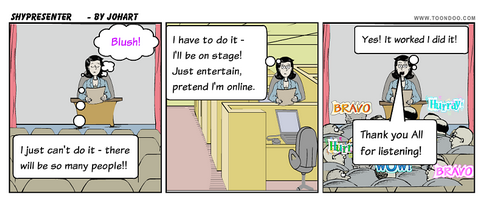
The tendency to stand outside and watch myself has carried over into my role as an educator. I think that one of the reasons that I am not generally good at reflecting in writing after an event is because I am constantly operating a very short duration reflective cycle during a class or immediately afterwards. This is especially so with respect to “critical incidents” so by the time I get near a keyboard (trying to handwrite reflections kills them stone dead for me) and have time to write everything has already happened in my head so writing it seems unnecessary.
Educator as Entertainer?
Anyway enough of these digressions, Phil and myself were discussing how we work with students in different contexts. As an illustration of the way I adopt a different persona I talked about the recent two day professional development forum for lecturers in my organisation. In my experience across a number of organisations both here in Western Australia and formerly in the UK these sorts of events are generally disliked for various reasons including: information overload; the time taken; and the fact that not all of the sessions will be relevant or interesting to everyone. So to be asked to speak almost at the end of the two days about a topic that is certainly not “dear to the hearts” of many of my colleagues was a daunting prospect.
I decided right from the start that whatever I did: had to be fast-paced but also conversational in style; had in some way to entertain as well as to engage; and also had to have some degree of interactivity. Being up on stage with a microphone and data projector is not the ideal situation for generating engagement or including interactivity but it can provide opportunities to entertain! Because several colleagues expressed an interest in the slides and links I had used within them I have uploaded them to Slideshare.
I work in vocational education albeit as a literacy/numeracy educator. Because of the context the vocationl skills of my colleagues are very highly valued and constantly updated so in my session I tried to draw a parallel between this and the need to have comparable skills in the teaching strategies and e-tools that suit the needs of our 21st Century learners. I also raised the issue that while we try to make learning as flexible as possible for our students using numerous blends often customised for the individual our own professional development is still tending to follow the old model of all sit in a room together and listen to speakers talking about subjects often chosen by others not ourselves. Developing and accessing a PLN, attending webinars and blogging about educator related topics are easily recorded and tracked these days so there is no reason why these shouldn’t form part of our recognised professional development. The session generated some interest from colleagues as several have arranged to catch up with me next term and talk about some of the possibilites for some of the “e” strategies in their own teaching areas.
Conclusion
When I consider how I work with my regular students I think it is critical to try and engage them but it is less important to entertain them. However when I am trying to bring colleagues on board with something new being entertaining becomes vital in order to generate a positive memory of the message.
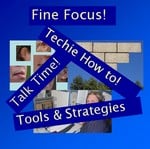 Our next Webinar is a FineFocus session. Join Phil Hart (@philhart) for “E-portfolios – a personal journey” in which Phil will share his experience of developing e-portfolios to provide complete evidence for Recognition of Prior Learning in higher level vocational qualifications. Join us on Thursday Jan 10th at 23:00 GMT/UTC the time for you will vary depending on your timezone (check yours here) Thursday afternoon/evening in the USA, late night Thursday in Europe, and Friday morning Jan 11th in Australia – in the usual Blackboard Collaborate virtual room.
Our next Webinar is a FineFocus session. Join Phil Hart (@philhart) for “E-portfolios – a personal journey” in which Phil will share his experience of developing e-portfolios to provide complete evidence for Recognition of Prior Learning in higher level vocational qualifications. Join us on Thursday Jan 10th at 23:00 GMT/UTC the time for you will vary depending on your timezone (check yours here) Thursday afternoon/evening in the USA, late night Thursday in Europe, and Friday morning Jan 11th in Australia – in the usual Blackboard Collaborate virtual room.
